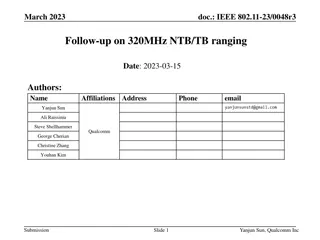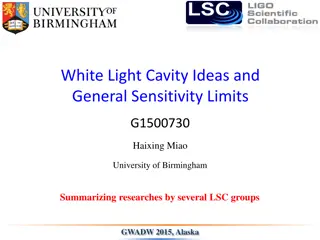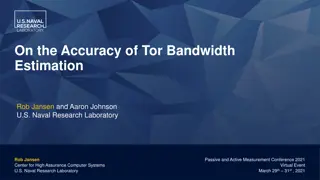IEEE 802.11-23/1288r0 Bandwidth Utilization Proposal
This proposal aims to improve bandwidth utilization in IEEE 802.11 networks by allowing devices to transmit on idle channels within the operating bandwidth. It addresses the inefficiencies caused by the current limitation where devices do not transmit on idle portions if the primary channel is busy.
3 views • 24 slides
Challenges and Requirements for Bandwidth Indication in IEEE 802.11
The document discusses challenges and requirements related to bandwidth indication in RTS/CTS frames with PPDU in 320 MHz, focusing on scenarios where bandwidth signaling may lead to misinterpretation by stations. It highlights the need for dynamic bandwidth and preamble puncturing information in RT
5 views • 21 slides
Proposal for Efficient Bandwidth Utilization in IEEE 802.11 Networks
This proposal aims to address the inefficient utilization of bandwidth in IEEE 802.11 networks by allowing stations to transmit on idle channels within their operating bandwidth. The document discusses the problem statement, high-level solution, relevant capabilities of transmitters and receivers, p
1 views • 15 slides
IEEE 802.11 Proposal for 320MHz Ranging Enhancement
This document discusses the proposal for enhancing IEEE 802.11 with support for 320MHz bandwidth ranging operations. It aims to improve ranging accuracy by expanding 802.11az frames and procedures to accommodate the increased bandwidth. The focus is on MAC-related changes, exploring different option
6 views • 26 slides
Dealing with Range Anxiety in Mean Estimation
Dealing with range anxiety in mean estimation involves exploring methods to improve accuracy when estimating the mean value of a random variable based on sampled data. Various techniques such as quantile truncation, quantile estimation, and reducing dynamic range are discussed. The goal is to reduce
4 views • 12 slides
Advances in White Light Cavity for Sensitivity and Bandwidth Optimization
The research discusses innovative ideas for enhancing sensitivity and bandwidth limits in the context of white light cavity technologies. It explores methods such as external/internal squeezing and signal recycling to surpass existing Mizuno Limits, shedding light on crucial issues for future upgrad
2 views • 27 slides
Enhancing Memory Cache Efficiency with DRAM Compression Techniques
Explore the challenges faced by Moore's Law in relation to bandwidth limitations and the innovative solutions such as 3D-DRAM caches and compressed memory systems. Discover how compressing DRAM caches can improve bandwidth and capacity, leading to enhanced performance in memory-intensive application
1 views • 48 slides
Enhancing Support for Wider Bandwidth OFDMA in IEEE 802.11 Networks
The document discusses the implementation of Selective Spatial Transmission (SST) and Dynamic Subband Operation (DSO) to enable wider bandwidth OFDMA in IEEE 802.11be and 802.11bn standards. It covers enhancements for 80MHz, 160MHz, and 320MHz EHT DL and UL OFDMA transmissions, emphasizing the benef
4 views • 18 slides
Foundations of Parameter Estimation and Decision Theory in Machine Learning
Explore the foundations of parameter estimation and decision theory in machine learning through topics such as frequentist estimation, properties of estimators, Bayesian parameter estimation, and maximum likelihood estimator. Understand concepts like consistency, bias-variance trade-off, and the Bay
1 views • 15 slides
Software Development Cost Estimation Best Practices
Explore key principles and techniques for accurate cost estimation in software development projects. Discover the importance of the 5WHH principle, management spectrum, critical practices, resource estimation, estimation options, and decomposition techniques for improved project planning. Learn abou
3 views • 40 slides
IEEE 802.11-23/2141r0 Dynamic Subband Operation Discussion
Discussion on Dynamic Subband Operation in IEEE 802.11-23/2141r0 focusing on enabling flexible bandwidth allocation between APs and non-APs for improved resource utilization and system performance. The proposal aims to address bandwidth mismatches and enhance efficiency in channel access allocation
2 views • 15 slides
Bandwidth and Packet Type Detection Schemes for 40-50GHz Millimeter Wave Communication Systems
The document discusses bandwidth and packet type detection schemes for 40-50GHz millimeter wave communication systems in IEEE 802.11aj specifications. It proposes a preamble design for auto-detection of bandwidth and packet type to improve channel estimation and decoding efficiency. By utilizing dif
4 views • 27 slides
Congestion Control for High Bandwidth-Delay Product Networks
This presentation discusses the challenges faced by TCP in high bandwidth-delay product networks, highlighting issues such as oscillations and instability. It explores solutions like adjusting aggressiveness based on feedback delay, decoupling efficiency and fairness control, and introduces XCP as a
3 views • 23 slides
Optimized Content Transfer in Mesh Networks Using Bandwidth-Aware Chunking
This presentation by Gurdev Singh from Samsung addresses a technique for optimized content transfer in mesh networks by splitting content into file chunks based on the bandwidth of the channel. By considering the bandwidth or link quality of destination nodes, the content is divided so that lower ba
4 views • 20 slides
Enhancing Off-chip Bandwidth Utilization for Improved System Performance
Efficiently coordinating off-chip read/write bandwidth through the Bandwidth-aware LLC proposal yields a 12% performance improvement in an 8-core system across multiple workloads. This approach optimizes DRAM read latency, surpassing existing policies and filling performance gaps while confirming lo
4 views • 36 slides
Time Distribution System R&D Update for Hyper-Kamiokande Experiment
In the February 2020 update, Stefano Russo from LPNHE Paris presented the progress on the time distribution system R&D for the Hyper-Kamiokande experiment. The focus is on implementing a bidirectional data exchange link with a large bandwidth capacity for synchronous, phase-deterministic protocol. T
0 views • 17 slides
Accuracy of Tor Bandwidth Estimation Study
Study by Rob Jansen and Aaron Johnson from the U.S. Naval Research Laboratory reveals that Tor underestimates its network bandwidth capacity, with significant errors in estimation for high-capacity relays, exit relays, and relays with lower uptimes. The findings emphasize the importance of accurate
1 views • 16 slides
Cognitive Passive Estimation of Available Bandwidth in Overlapped IEEE 802.11 WiFi WLANs
Efficient bandwidth estimation is crucial for network management and QoS applications, with cognitive passive methods offering insights without additional traffic loads. This research explores the impact of control messaging overhead, network topology, channel usage, hidden/exposed terminals, and pa
4 views • 13 slides
DeltaINT: General In-band Network Telemetry with Low Bandwidth Overhead
This paper discusses DeltaINT, a novel framework for in-band network telemetry aimed at reducing bandwidth overhead while ensuring high generality and convergence. It addresses the limitations of existing methods by providing theoretical analysis on bandwidth mitigation guarantees and offering softw
4 views • 20 slides
Meeting Home Networking Bandwidth Needs with GEPOF Technology
Gigabit Ethernet over Polymer Optical Fiber (GEPOF) is a promising technology addressing the growing bandwidth requirements in home networking. Advances in FTTH technology enable high-speed connections for Smart Homes, supporting services like cloud computing, 4K video streaming, and Internet of Thi
4 views • 15 slides
Intelligent DRAM Cache Strategies for Bandwidth Optimization
Efficiently managing DRAM caches is crucial due to increasing memory demands and bandwidth limitations. Strategies like using DRAM as a cache, architectural considerations for large DRAM caches, and understanding replacement policies are explored in this study to enhance memory bandwidth and capacit
4 views • 23 slides
Bandwidth and Dispersion in Fiber Optic Communication
This presentation provides a comprehensive overview of bandwidth and dispersion in fiber optic communication. It covers essential terminologies like microns, nanometers, millimeters, and dB, explaining concepts such as bandwidth capacity, dispersion cancellation, and modal bandwidth in multimode fib
4 views • 24 slides
Evolution of Communication Systems: From Bandwidth Division to Spread Spectrum
Third-generation communication systems utilize Pseudo-Noise (PN) codes to share bandwidth without interference, while first and second-generation systems divide bandwidth into smaller channels. PN codes are vectors with 1s and -1s, orthogonal to each other. Users transmit data using PN coding, combi
3 views • 14 slides
Advanced Gaze Estimation Techniques: A Comprehensive Overview
Explore advanced gaze estimation techniques such as Cross-Ratio based trackers, Geometric Models of the Eye, Model-based Gaze Estimation, and more. Learn about their pros and cons, from accurate 3D gaze direction to head pose invariance. Discover the significance of Glint, Pupil, Iris, Sclera, and C
4 views • 40 slides
Overview of UE RF Requirements for 35/45MHz Channel Bandwidth in 3GPP Meeting #97-e
The document discusses the introduction of 35/45MHz channel bandwidth in UE RF requirements for various bands. It covers equation-based requirements and limitations in UL configurations based on bandwidth allocation. The scope includes capturing content from the first round discussions and clarifyin
0 views • 16 slides
Enhancing Bandwidth of Channel State Information (CSI) for Wireless Sensing Applications
This submission delves into the necessity of expanding the bandwidth of Channel State Information (CSI) in wireless environments to cater to the demands of time-sensitive wireless sensing applications. It explores the implications of high-bandwidth CSI on enhancing wireless channel understanding, ac
2 views • 12 slides
Enhancing Memory Bandwidth with Transparent Memory Compression
This research focuses on enabling transparent memory compression for commodity memory systems to address the growing demand for memory bandwidth. By implementing hardware compression without relying on operating system support, the goal is to optimize memory capacity and bandwidth efficiently. The a
3 views • 34 slides
Reinforcement Learning for Bandwidth Estimation in Real-Time Communications
This study presents a novel approach utilizing reinforcement learning for real-time bandwidth estimation and congestion control in communication networks. The focus is on improving two-way video streaming applications by addressing challenges such as limited upload speed, dynamic network conditions,
1 views • 10 slides
Toggle-Aware Compression for GPU Systems
Data compression can reduce bandwidth pressure, but it also increases energy costs due to bit toggles. Toggle-Aware Compression Energy Control (EC) and Metadata Consolidation (MC) aim to mitigate this issue. This approach reduces bit toggles, maintaining performance benefits. The importance of energ
2 views • 26 slides
Discussion on Bandwidth Issue in IMMW
In this January 2024 document, the authors from Huawei address the bandwidth concerns in IMMW (IEEE 802.11-17/0167r0). They summarize key points from a previous meeting, propose various bandwidth contributions, and compare different bandwidth modes based on data rate, spectral efficiency, and techni
3 views • 55 slides
Relationship Between Bit Rate and Transmission Bandwidth
Explore the fundamental concepts of digital communications, including PCM transmission bandwidth, sampling rates, quantization levels, and the relationship between bit rate and transmission bandwidth. Learn how to calculate the minimum transmission bandwidth required for binary-coded signals and tim
0 views • 13 slides
Digital Communications and PCM: Advantages, Limitations, and Bandwidth Analysis
Explore the world of digital communications in the context of PCM, focusing on its advantages, limitations, and bandwidth implications. Understand the impact of increasing the number of bits on signal-to-noise ratio and transmission bandwidth. Discover the applications of PCM in audio and video tran
3 views • 13 slides
Passive Estimation of Available Bandwidth in Overlapped IEEE 802.11 WiFi WLANs
Explore the cognitive passive estimation of available bandwidth in IEEE 802.11 WiFi networks, focusing on efficient resource management and QoS support. The approach involves analyzing channel usage, control messaging overhead, hidden/exposed terminals impact, and packet size considerations for accu
1 views • 13 slides
Proposed Mechanism for UHR Operating Bandwidth Indication
The document proposes a mechanism for a UHR AP to indicate a nominal and expanded operating channel width, defining the BSS bandwidth for UHR features. It addresses scenarios where BSS bandwidth needs to be limited for specific purposes, offering a solution for effective bandwidth indication.
2 views • 13 slides
Insights into Distributed RU Bandwidth Optimization in IEEE 802.11-23
Explore the latest developments in optimizing distributed RU bandwidth within the IEEE 802.11-23 standard. This document delves into crucial aspects such as DRU size, operation modes, and distribution bandwidth considerations. Discover how factors like preamble puncturing and operating bandwidth imp
0 views • 8 slides
Proposed Two-Step Reachability Estimation for mmWave Networks
This document discusses the proposed two-step reachability estimation approach for mmWave networks, focusing on the benefits it provides and the structure of the estimation process. It emphasizes the importance of initial estimation in the sub-7GHz band followed by a finer estimation in the mmWave b
5 views • 23 slides
MmWave Reachability Estimation Structure for IEEE 802.11-25/0300r0 Document
Explore the two-step reachability estimation approach proposed for IMMW in the IEEE 802.11-25/0300r0 document. Understand the initial estimation in sub-7GHz and subsequent mmWave band estimation using beam training, aiming to enhance reachability while minimizing computational burden. Dive into the
4 views • 16 slides
Bandwidth Estimation Metrics and Measurement Techniques
Explore various bandwidth estimation metrics, measurement techniques, and tools for accurate bandwidth assessment. Learn about capacity-related metrics, available bandwidth, bulk transfer capacity, and probing techniques like Variable Packet Size (VPS) for evaluating network bandwidth along a path.
0 views • 17 slides
Bandwidth Expansion Method in TXOP Sharing for IEEE 802.11-24/1924r0
Enhance P2P communication through a proposed bandwidth expansion method in the TXOP sharing process for IEEE 802.11be. This method addresses limitations in bandwidth sharing between APs and non-AP STAs, allowing for wider bandwidth utilization during P2P operations within allocated time frames. Fair
2 views • 5 slides
Discussion on 240MHz Bandwidth Proposal
Explore the proposal for IEEE 802.11-19/1889r2 supporting 240/160+80 MHz transmission in the November 2019 document. The discussion focuses on the benefits of utilizing 240/160+80 MHz bandwidth for improved throughput and efficiency, presenting a tone plan and bandwidth indication method. Discover h
3 views • 15 slides







































